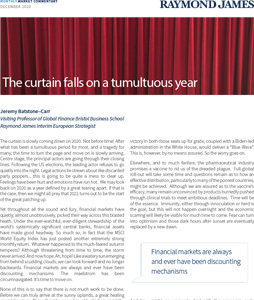The curtain is slowly coming down on 2020. Not before time! After what has been a tumultuous period for most, and a tragedy for many, the time to turn the page and move on is slowly arriving. Centre stage, the principal actors are going through their closing lines. Following the US elections, the leading actor refuses to go quietly into the night. Legal actions lie strewn about like discarded party poppers…
Ramblings of a Wealth Manager – 9 December 2020
Ramblings of a Wealth Manager – 3 December 2020
Bye bye RPI
Last week Rishi Sunak delivered his eagerly anticipated spending review. We were not expecting good news and we did not get any. Amongst the headlines were that we will suffer our deepest recession since the Great Frost of 1709 and a public sector pay freeze for all non-health roles.
Hidden in amongst the detail was the confirmation that the widely used inflation reference index of RPI would be scrapped from 2030 and replaced by CPIH. This has been discussed previously and was potentially going to come in from 2025.
Definitions:
- RPI – Retail price index – this index tracks the cost of a fixed basket of goods over time but no housing input.
- CPIH – Consumer price index plus housing – this tracks a slightly different basket of goods but includes a housing element (living costs not house price movements). This measure is seen as more realistic to actual inflation nowadays.

Why does this matter?
Historically CPIH typically runs about 0.8% below RPI.
So what?
Well RPI is the reference rate used in calculating payments of approximately two thirds of final salary pension schemes, some annuity payments and the income and capital returns linked to the majority of older index linked gilts. It is estimated that the change in the measure could cost index inked gilt holders up to £96bn.
A lower rate means a lower payment for holders of the above securities. The government has stated that no compensation will be available to those impacted.
The relentless war on savers continues.
Ramblings of a Wealth Manager – 18th November 2020
Optimism can be contagious too
After a rough, tough performance month in the pan-European equity markets, the instinct is always to look away from the detailed data and conclude in a world of tightening pandemic restrictions and an imminent (and hotly contested) American presidential election, that uncertainty must induce investment caution.
TRADE, DISPUTES AND NOVEMBER’S ELECTION
This October marks 80 years since the opening of the Pennsylvania Turnpike, America’s first highway. Highways have been a critical driver of economic growth due to the connectivity, speed, and efficiency they provide. As Confucius so appropriately stated, “roads were made for journeys, not destinations.”
Feeling Lucky
The traditional early September think piece centres on the natural reset that a generalised return to work (and for the younger generation, school) brings after the typically languid summer holiday period. As 2020 is clearly a very different style of year, let us rip up the normal script and ask the simpler question of ‘does the world feel lucky?’
A different summer pause
Financial markets are always a three-dimensional jigsaw, with new pieces being added and deleted at whim every business day. But the signals from the last month have been especially difficult to discern. In contrast to the bounce back second quarter, July was a negative month for pan-European markets with the U.K. continuing to lag.
THE ROAD TO RECOVERY
We maintain our belief in the ‘American Dream’ as described by James Truslow Adams, that “life should be better and richer and fuller for everyone, with opportunity for each according to ability or achievement,” regardless of social class or circumstances of birth. We not only acknowledge but embrace that we have work to do as a society, and hope that this year will serve as an inflection point as we advance toward a stronger and more united world.
The end of the beginning
Over three hundred and fifty years ago, back in 1665, Isaac Newton socially distanced himself from the horrors of the then rampant bubonic plague and – away from his burgeoning academic career at Trinity College in Cambridge – enjoyed a ‘year of wonders’ at his childhood home. During this period he formulated a theory of universal gravitation, explored optics and discovered differential and integral calculus.














